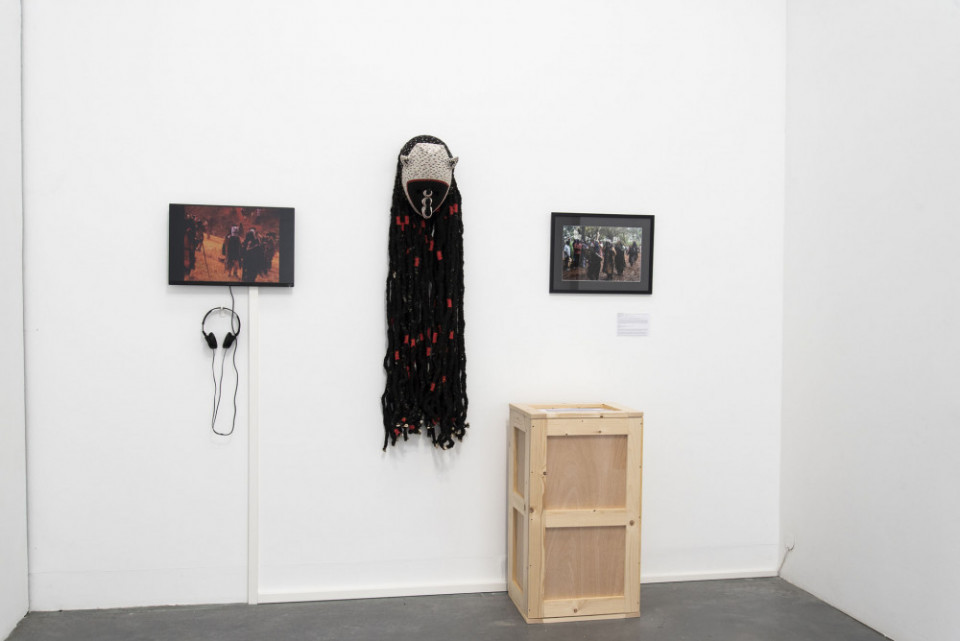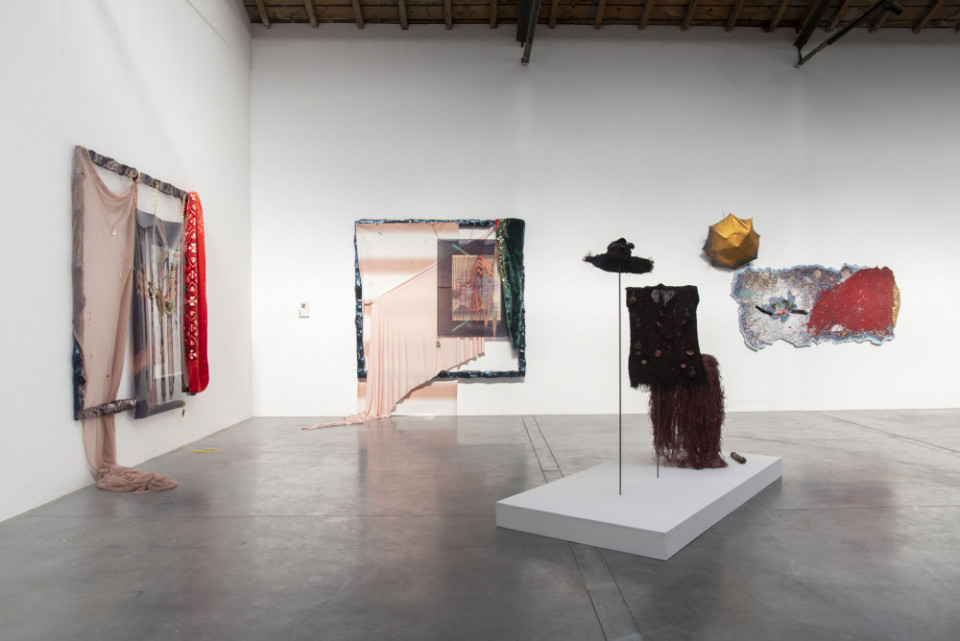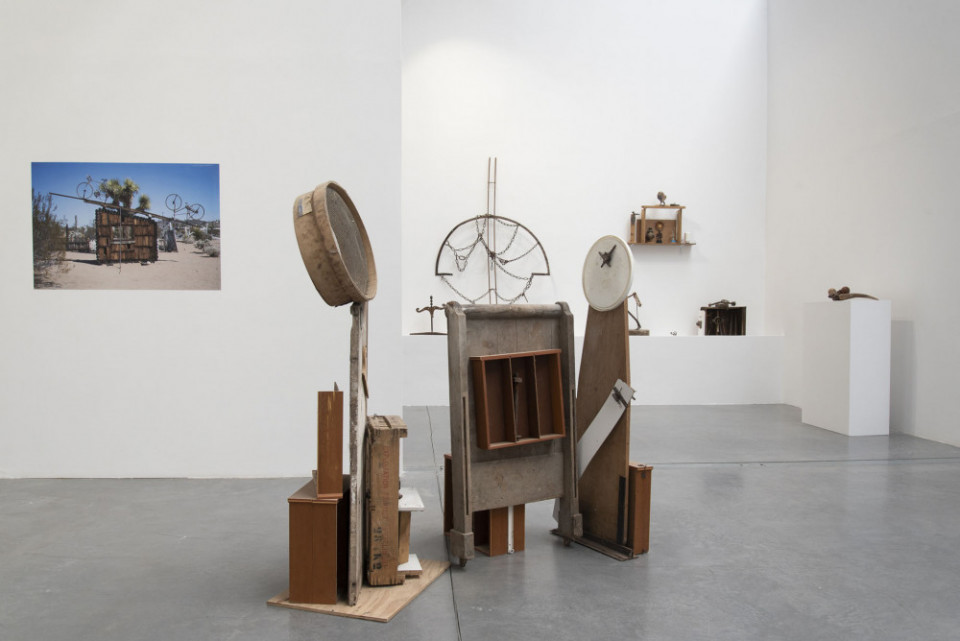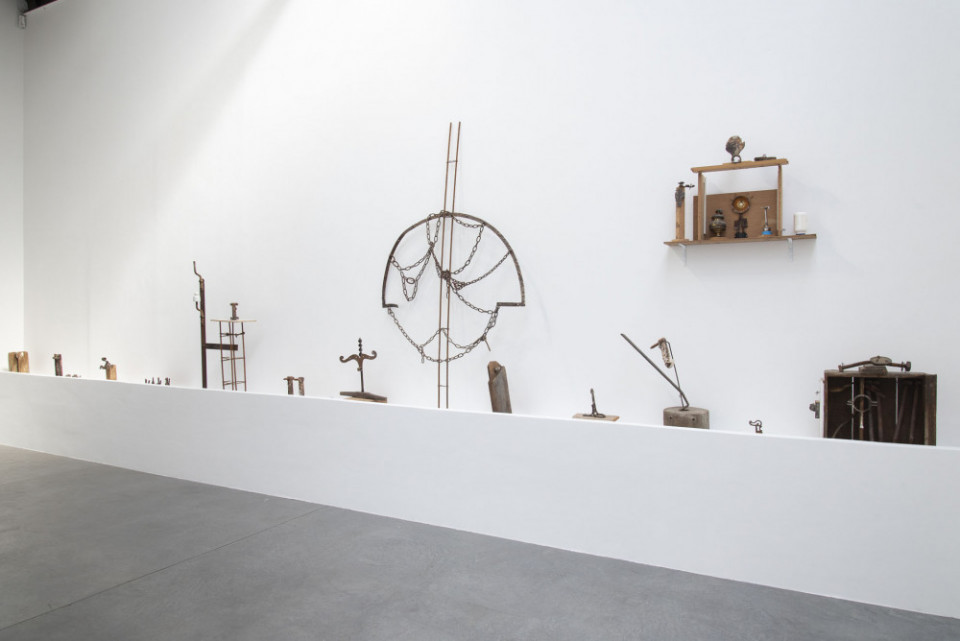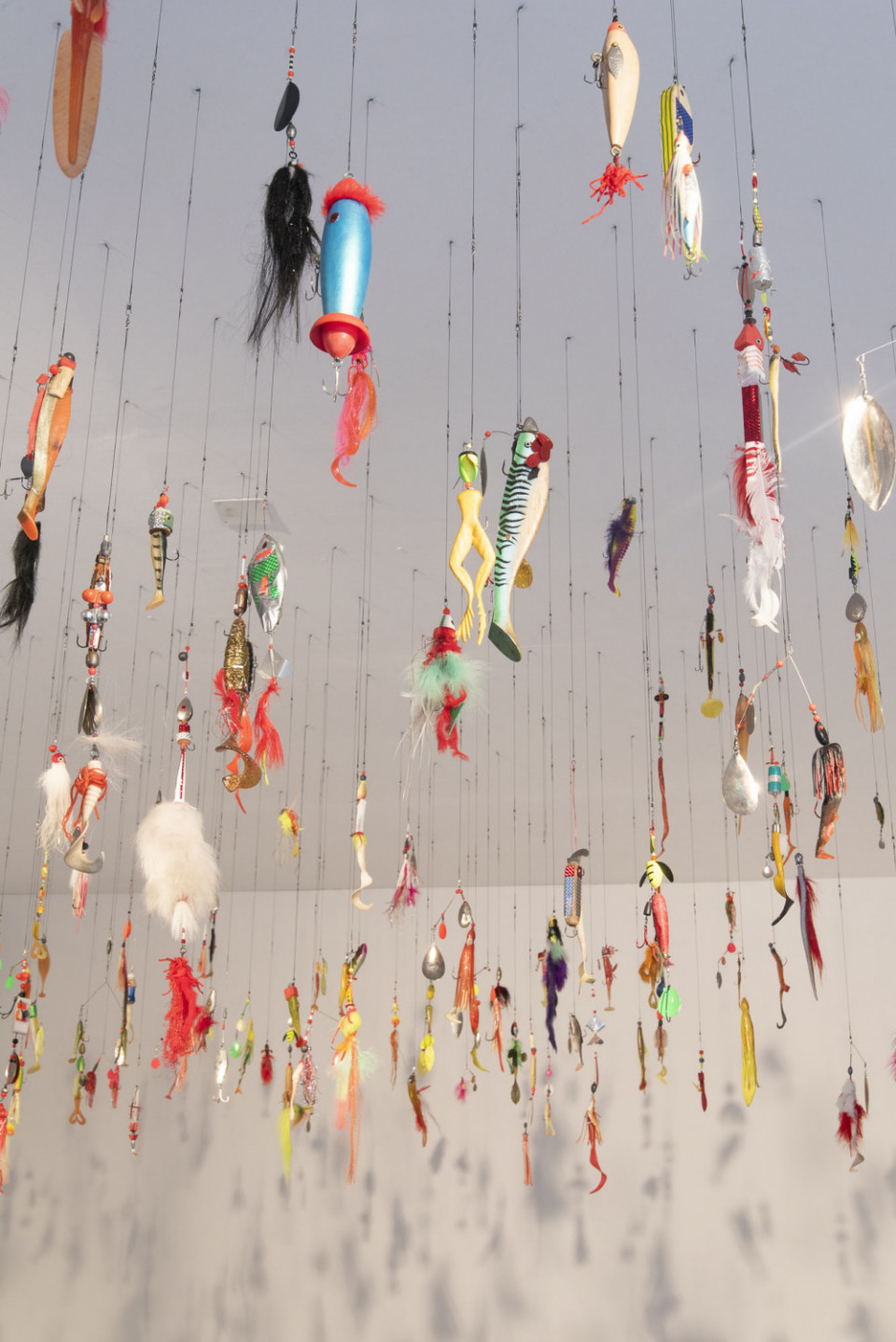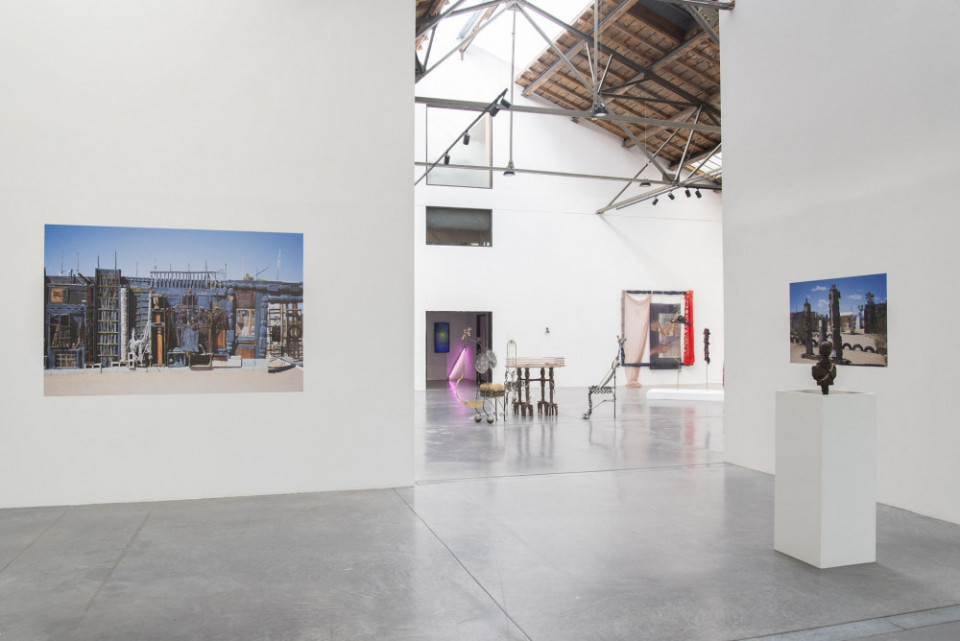Se souvenir du présent, esprits de l'assemblage
Exposition collective
Exposition
Avec : Nils Alix-Tabeling, Archives des forêts, Wallace Berman, Michael Buthe, Gaëlle Choisne, Julien Creuzet, Michel Gaillot et Jean-Baptiste Sauvage, George Herms, Aurélia Jaubert, Fred Mason, objets vodoun de la collection de Gabin Djimassé, Stuart Perkoff, Sarah Pucci, Noah Purifoy, Hervé Youmbi
Commissariat Anne Giffon-Selle et Arnaud Zohou
L’assemblage promeut une esthétique du non-fini où il s’agit d’ouvrir un nouveau champ qui permet aux gens de penser et d’agir par eux-mêmes (Michael McClure1).
Dans Une histoire vraie, film de David Lynch, le protagoniste qui traverse les États-Unis sur une tondeuse à gazon pour rejoindre son frère mourant explique à une jeune femme en errance ce qu’est une famille. Il prend une tige de bois, image alors de l’individu isolé, et la casse en deux, aisément. Il assemble alors une quinzaine de branchettes qu’il serre et attache avec un fil, et tente sans succès de briser le fagot constitué, montrant ainsi à ses yeux ce qu’est une famille, collectif électif ou « naturel ». Il use ainsi de « la technique de l’assemblage, technique artisanale de la solidité qui vise à faire un seul bloc avec plusieurs »2. En peu de mots et par cet acte de juxtaposer ou d’agglomérer divers éléments pour fabriquer une nouvelle entité qui seule donne en retour une véritable consistance à chacun des membres, il montre ce que comprend toute pratique intensive de l’assemblage : un processus d’individuation à travers une expérience collective, révélant une dimension symbolique (psychologique voire spirituelle) liée à une autre profondément sociale.
L’art de l’assemblage est en effet traversé par ce principe d’élaboration d’une nouvelle réalité à partir du rapprochement plus ou moins bricolé de ce qui est séparé, hétéroclite, tout en préservant la singularité de chaque élément constitutif. Par essence inclusif, le procédé se situe à la croisée de l’empirisme matérialiste et du spirituel, de l’artistique, du populaire et du politique, quand il n’accueille pas concomitamment en son sein plusieurs temporalités (celle, parfois désuète, du remploi tout comme le zeitgeist du moment de sa réalisation). L’exposition proposera donc des œuvres en provenance de diverses époques (des années 1950 à nos jours) et continents (africain, américain et européen), et inclura également les divers champs d’activité que les artistes eux-mêmes revendiquent au fondement de leur pratique (objets et environnements populaires, objets rituels et votifs). Ainsi de quelques offrandes temporelles (cadeaux d’anniversaire), mais aussi de la culture afro-américaine, et derrière elle, des sources africaines qui l’irriguent à travers notamment celles venues du Bénin, ancien Dahomey, là où s’est développé le vodoun diffusé ensuite dans les Amériques et les Caraïbes à travers l’esclavage, et dont l’esthétique depuis des siècles est constituée de travaux d’assemblage.
Les principes et caractéristiques énoncés précédemment font de l’assemblage un paradigme dépassant largement le seul procédé technique. Ce « champ élargi »3 de l’assemblage se dévoilera tant dans la variété des médiums utilisés par les plasticien.ne.s ici convié.e.s (collage, sculpture, peinture, texte, installation), que dans ses multiples ramifications (found footage cinématographique, cut-up littéraire, mixage et sampling musicaux).
Anne Giffon-Selle et Arnaud Zohou
1- Michael McClure, Lighting the corners. On Art, Nature, and the Visionary, 1993. University of New Mexico Press, Albuquerque, p. 8 : « that’s in this change that we open the possibilities for a newground upon which people may think and act ».
2- Gilbert Simondon, Entretien sur la mécanologie, 1968.
3- Pour paraphraser Rosalind Krauss, « La sculpture dans le champ élargi », dans L’originalité de l’avant-garde et autres mythes modernistes, Macula, 1985.
Catalogue de l’exposition disponible ici
The assemblage promotes an esthetics of unfinished in order to open a new field whichenables people to think and to act by themselves (Michael McClure1).
In David Lynch’s The Straight Story, the protagonist, traveling across the United States on a lawn mower in order to visit his dying brother, tells a runaway girl about the importance of family. He takes a wooden stick representing an isolated individual, easily breaking it in two. He then ties together a dozen small twigs in a bundle and fails to break it, illustrating his notion of the family as an elective or “natural” collective. In doing so, the character uses the “technique of assemblage, an artisanal technique of solidity aiming at creating a single block out of several ones”2. Using only a few words, and through this act of juxtaposing or agglomerating various elements in order to construct a new entity that by itself provides a genuine consistency to each of the members, he unveils what is at the core of every intensive practice of assemblage: a process of individuation through collective experience, revealing a symbolic (as well as psychological and even spiritual) dimension boundto a powerful social sense.
The art of assemblage is indeed infused with the principle of building off a new reality out of the cobbling-together of distinct, heterogeneous elements while preserving the singularity of each constitutive component. Inclusive in essence, this process lays at the crossroads of materialist empiricism and of the spiritual, the artistic, the popular and the political, and occasionally accommodates several temporalities (the sporadically quaint temporality of waste as well as the Zeitgeist of the time of its creation). This exhibition will thus feature works from different periods (from the 1950s to now) and continents (Africa, America, Europe), and include various fields of activities identified by the artists as foundational to their practice (popular objects and environments, ritual and votive objects). Hence the presence of several temporal offerings (anniversary presents), as well as African-American culture and the African sources that have informed it, with a focus on vodoun, a religion whose aesthetic has relied on assemblage for centuries, originating in Benin (formerly Dahomey) before traveling tothe Americas and the Caribbean with the slave trade.
In light of the previously described principles and characteristics, assemblage becomes paradigm that largely exceeds the mere technical process. This “expanded field”3 of assemblage will be highlighted by the variety of media used by the invited artists (collage, sculpture, painting, writing, installation) as well as by its manifold ramifications(found footage, cut-up, mixing and sampling).
Anne Giffon-Selle et Arnaud Zohou
1-Michael McClure, Lighting the corners. On Art, Nature, and the Visionary, 1993. University of New Mexico Press, Albuquerque, p. 8 : « that’s in this change that we open the possibilities for a new ground upon which people may think and act ».
2-Gilbert Simondon, Entretien sur la mécanologie, 1968.
3-To reword Rosalind Krauss, « The sculpture in the expanded field » in The originality of the Avant-garde and other modernist myths, Macula, 1985.


